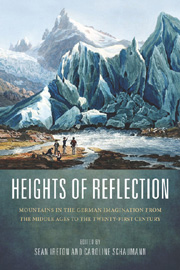 Heights of Reflection
Heights of Reflection Book contents
- Frontmatter
- Contents
- Acknowledgments
- Introduction: The Meaning of Mountains: Geology, History, Culture
- Prelude: Classical Mountain Landscapes and the Language of Ascent
- Part I First Forays: Mountain Exploration and Celebration from the Middle Ages to the Eighteenth Century
- Part II Beckoning Heights: Summits Near and Far in the Nineteenth Century
- Part III Modern Expeditions and Evocations: Climbing from the Twentieth into the Twenty-First Century
- Leaving the Summit Behind: Tracking Biographical and Philosophical Pathways in Richard Strauss's Eine Alpensinfonie
- Elevation and Insight: Thomas Mann's Der Zauberberg
- “The Essence of the Alpine World Is Struggle”: Strategies of Gesundung in Arnold Fanck's Early Mountain Films
- “Mountain of Destiny”: The Filmic Legacy of Nanga Parbat
- Spatial Orientation and Embodied Transcendence in Werner Herzog's Mountain Climbing Films
- W. G. Sebald's Magic Mountains
- Conflicting Ascents: Inscriptions, Cartographies, and Disappearance in Christoph Ransmayr's Der fliegende Berg
- Works Cited
- Notes on the Contributors
- Index
Spatial Orientation and Embodied Transcendence in Werner Herzog's Mountain Climbing Films
from Part III - Modern Expeditions and Evocations: Climbing from the Twentieth into the Twenty-First Century
Published online by Cambridge University Press: 05 February 2013
- Frontmatter
- Contents
- Acknowledgments
- Introduction: The Meaning of Mountains: Geology, History, Culture
- Prelude: Classical Mountain Landscapes and the Language of Ascent
- Part I First Forays: Mountain Exploration and Celebration from the Middle Ages to the Eighteenth Century
- Part II Beckoning Heights: Summits Near and Far in the Nineteenth Century
- Part III Modern Expeditions and Evocations: Climbing from the Twentieth into the Twenty-First Century
- Leaving the Summit Behind: Tracking Biographical and Philosophical Pathways in Richard Strauss's Eine Alpensinfonie
- Elevation and Insight: Thomas Mann's Der Zauberberg
- “The Essence of the Alpine World Is Struggle”: Strategies of Gesundung in Arnold Fanck's Early Mountain Films
- “Mountain of Destiny”: The Filmic Legacy of Nanga Parbat
- Spatial Orientation and Embodied Transcendence in Werner Herzog's Mountain Climbing Films
- W. G. Sebald's Magic Mountains
- Conflicting Ascents: Inscriptions, Cartographies, and Disappearance in Christoph Ransmayr's Der fliegende Berg
- Works Cited
- Notes on the Contributors
- Index
Summary
Es ist offenbar viel schwieriger, den Berg auf die Leinwand als den Menschen auf den Berg zu bringen.
—Reinhold Messner, 13 Spiegel meiner Seele[It is apparently much more difficult to bring a mountain to the movie screen than to put a person on the mountain.]
In 1984 Herzog accompanied the famous South Tyrolean mountain climber Reinhold Messner on an expedition to the central Karakoram mountain range in northeastern Pakistan to film the latter's attempt at an unprecedented climbing feat. Messner and his fellow climber Hans Kammerlander were seeking to become the first to ascend two 8,000-meter peaks (Gasherbrum I and Gasherbrum II) in succession without returning to base camp. In a voiceover during an extended panning shot of the Karakoram at the beginning of the film, Herzog lays out what he wanted to explore in the resulting television documentary, Gasherbrum — Der leuchtende Berg (Gasherbrum — the glowing mountain, 1985):
Uns interessierte nicht so sehr einen Film über die bergsteigerische Tat oder über Klettertechnik zu machen. Was wir wissen wollten, war: was geht in Bergsteigern vor, die so etwas Extremes unternehmen?
[We weren't so much interested in making a film about mountain climbing per se, or about climbing techniques. What we wanted to find out was what goes on inside mountain climbers who undertake such extreme endeavors.]
- Type
- Chapter
- Information
- Heights of ReflectionMountains in the German Imagination from the Middle Ages to the Twenty-First Century, pp. 302 - 319Publisher: Boydell & BrewerPrint publication year: 2012


